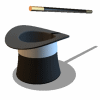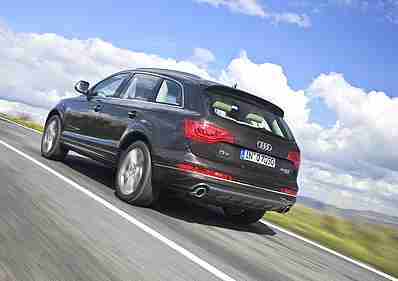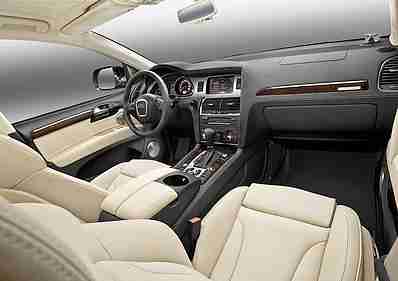
2009
Dirain

2009
ZUR DEUTSCHEN VERSION
 |
The Audi Q7 - the new generation
Even more elegant,
more efficient, and with even lower emissions: Audi has further improved
on the strengths of the Q7 SUV and made it even better - more refined, more
elegant, and more efficient. This line-up features the Audi Q7 3.0 TDI quattro,
a new TDI clean diesel version.
 This has the world's cleanest diesel technology
and consumes only 8.9 liters of fuel per 100 kilometers (26.43 US mpg). The
Audi Q7 is a sporty, comfortable, high-performance car for leisure and business.
It is the large Audi for customers looking for a vehicle that can take them
anywhere and is roomy and flexible, with a high payload and hefty towing
capability. And this character is immediately evident in the design: the
side view with the low window area, the arched roof line and the tautly curved
body surfaces presents a coupe-like silhouette. New accents at the front
and rear contribute to even more elegant styling and visual impact. In
conjunction with the optional xenon headlights, light-emitting diodes arranged
to form U-shaped bands provide the daytime running lights. The turn signals
too are composed of LEDs. Audi also supplies an optional high-end headlight
version that integrates not only a low beam, high beam, and turning and cornering
lights, but for the first time also a special superhighway beam. The restyled
tailgate presents a more forceful contour. LEDs are standard equipment in
the taillights. An aluminum exterior package adds further highlights to the
styling. The S line exterior package is designed for sports-minded customers.
The Audi Q7 is 509 centimeters (16.7 feet) long and has a 300-centimeter
(9.8-foot) wheelbase. It provides generous interior comfort, a cargo volume
of up to 2,035 liters (71.87 cubic feet), and unsurpassed variability. The
customer can order an interior with five, six or seven seats. An improved
easy entry function facilitates access all the way to the rear. Many improvements
down to the smallest details enhance personal comfort - including interior
lights in the door linings, an inlay on the passenger side, and new colors
as well as materials. The driver looks at redesigned instruments. Many
operator-control details have been refined and enhanced with chrome elements.
The S line sports package includes, among others, a black interior and sports
seats with top-quality covers, complemented by harder tuning of the suspension
and 20-inch wheels. All engines in the Q7 program are powerful and efficient
direct-injection versions. Standard equipment includes a six-speed tiptronic
that shifts swiftly and smoothly as it transfers the generated power to the
quattro permanent all-wheel drive system, which distributes it to the axles
with modest emphasis on the rear. In all V6 and V8 models Audi employs a
new technology from its modular efficiency platform. The energy recovery
system converts mechanical energy into electric energy during braking and
coasting, and buffer-stores it in the battery. It reduces CO2 emissions by
up to five grams per kilometer (8 g/mile). This improvement is even more
significant in busy traffic. This has the world's cleanest diesel technology
and consumes only 8.9 liters of fuel per 100 kilometers (26.43 US mpg). The
Audi Q7 is a sporty, comfortable, high-performance car for leisure and business.
It is the large Audi for customers looking for a vehicle that can take them
anywhere and is roomy and flexible, with a high payload and hefty towing
capability. And this character is immediately evident in the design: the
side view with the low window area, the arched roof line and the tautly curved
body surfaces presents a coupe-like silhouette. New accents at the front
and rear contribute to even more elegant styling and visual impact. In
conjunction with the optional xenon headlights, light-emitting diodes arranged
to form U-shaped bands provide the daytime running lights. The turn signals
too are composed of LEDs. Audi also supplies an optional high-end headlight
version that integrates not only a low beam, high beam, and turning and cornering
lights, but for the first time also a special superhighway beam. The restyled
tailgate presents a more forceful contour. LEDs are standard equipment in
the taillights. An aluminum exterior package adds further highlights to the
styling. The S line exterior package is designed for sports-minded customers.
The Audi Q7 is 509 centimeters (16.7 feet) long and has a 300-centimeter
(9.8-foot) wheelbase. It provides generous interior comfort, a cargo volume
of up to 2,035 liters (71.87 cubic feet), and unsurpassed variability. The
customer can order an interior with five, six or seven seats. An improved
easy entry function facilitates access all the way to the rear. Many improvements
down to the smallest details enhance personal comfort - including interior
lights in the door linings, an inlay on the passenger side, and new colors
as well as materials. The driver looks at redesigned instruments. Many
operator-control details have been refined and enhanced with chrome elements.
The S line sports package includes, among others, a black interior and sports
seats with top-quality covers, complemented by harder tuning of the suspension
and 20-inch wheels. All engines in the Q7 program are powerful and efficient
direct-injection versions. Standard equipment includes a six-speed tiptronic
that shifts swiftly and smoothly as it transfers the generated power to the
quattro permanent all-wheel drive system, which distributes it to the axles
with modest emphasis on the rear. In all V6 and V8 models Audi employs a
new technology from its modular efficiency platform. The energy recovery
system converts mechanical energy into electric energy during braking and
coasting, and buffer-stores it in the battery. It reduces CO2 emissions by
up to five grams per kilometer (8 g/mile). This improvement is even more
significant in busy traffic. |
Setting an example: The Q7 3.0 TDI clean diesel
quattro
 The 3.0 TDI
puts out 176 kW (240 hp) and delivers as much as 550 Nm (406 lb-ft) of torque
to the crankshaft - yet on the EU cycle it consumes only 9.1 liters of diesel
per 100 kilometers (25.85 US mpg). The optionally available 3.0 TDI clean
diesel actually uses only 8.9 liters of diesel per 100 kilometers (26.43
US mpg). It employs the world's cleanest diesel technology with a newly developed
catalytic converter that reduces nitrogen oxides. The 3.0 TDI clean diesel
quattro meets the exhaust emission standards of all 50 U.S. states as well
as the Euro 6 limits announced for 2014. In the Q7 4.2 TDI quattro, fuel
consumption has also been significantly improved - from 11.1 to 9.9 liters
per 100 km (22.19 to 23.76 US mpg), even though the power output of the V8
is increased to 250 kW (340 hp) and 760 Nm (561 lb-ft). The Q7 V12 TDI quattro,
the world's most powerful SUV, delivers 368 kW (500 hp) and 1,000 Nm (738
lb-ft) of torque - this top-of-the line model rivals the performance of a
powerful sports car. On average, the luxuriously equipped 12-cylinder car,
whose innovations are focused on the interior and the rear, consumes only
11.3 liters of fuel per 100 kilometers (20.82 US mpg). The gasoline engines
too combine efficiency and dynamism. The six-cylinder 3.6 FSI delivers 206
kW (280 hp) and 360 Nm (266 lb-ft) of torque. It consumes 12.1 liters/100
km (19.44 US mpg). The key figures for the 4.2 FSI are 257 kW (350 hp), 440
Nm (325 lb-ft) and 12.7 liters per 100 kilometers (18.52 US mpg). The suspension
of the Audi Q7 includes impressive advanced features. Standard equipment
of the Audi performance SUV includes 18-inch wheels, and options range all
the way to 21-inch sizes. An optional feature that enhances the sporty precision
of the car's handling as well as its strong off-road performance is the optional
adaptive air suspension (standard equipment in the 4.2 TDI and V12 TDI).
The combination of air suspension and electronically controlled shock absorbers
provides variable control of the ground clearance at five levels, as well
the three driving modes Comfort, Automatic und Dynamic. For the two V8 versions,
Audi optionally supplies carbon fiber-ceramic brake disks. These are
exceptionally large yet light in weight. The gray brake calipers are adorned
by the lettering "Audi ceramic" and contain a total of 24 pistons. For the
Q7 V12 TDI quattro, the ceramic brake system is standard equipment with 20-inch
aluminum wheels. The 3.0 TDI
puts out 176 kW (240 hp) and delivers as much as 550 Nm (406 lb-ft) of torque
to the crankshaft - yet on the EU cycle it consumes only 9.1 liters of diesel
per 100 kilometers (25.85 US mpg). The optionally available 3.0 TDI clean
diesel actually uses only 8.9 liters of diesel per 100 kilometers (26.43
US mpg). It employs the world's cleanest diesel technology with a newly developed
catalytic converter that reduces nitrogen oxides. The 3.0 TDI clean diesel
quattro meets the exhaust emission standards of all 50 U.S. states as well
as the Euro 6 limits announced for 2014. In the Q7 4.2 TDI quattro, fuel
consumption has also been significantly improved - from 11.1 to 9.9 liters
per 100 km (22.19 to 23.76 US mpg), even though the power output of the V8
is increased to 250 kW (340 hp) and 760 Nm (561 lb-ft). The Q7 V12 TDI quattro,
the world's most powerful SUV, delivers 368 kW (500 hp) and 1,000 Nm (738
lb-ft) of torque - this top-of-the line model rivals the performance of a
powerful sports car. On average, the luxuriously equipped 12-cylinder car,
whose innovations are focused on the interior and the rear, consumes only
11.3 liters of fuel per 100 kilometers (20.82 US mpg). The gasoline engines
too combine efficiency and dynamism. The six-cylinder 3.6 FSI delivers 206
kW (280 hp) and 360 Nm (266 lb-ft) of torque. It consumes 12.1 liters/100
km (19.44 US mpg). The key figures for the 4.2 FSI are 257 kW (350 hp), 440
Nm (325 lb-ft) and 12.7 liters per 100 kilometers (18.52 US mpg). The suspension
of the Audi Q7 includes impressive advanced features. Standard equipment
of the Audi performance SUV includes 18-inch wheels, and options range all
the way to 21-inch sizes. An optional feature that enhances the sporty precision
of the car's handling as well as its strong off-road performance is the optional
adaptive air suspension (standard equipment in the 4.2 TDI and V12 TDI).
The combination of air suspension and electronically controlled shock absorbers
provides variable control of the ground clearance at five levels, as well
the three driving modes Comfort, Automatic und Dynamic. For the two V8 versions,
Audi optionally supplies carbon fiber-ceramic brake disks. These are
exceptionally large yet light in weight. The gray brake calipers are adorned
by the lettering "Audi ceramic" and contain a total of 24 pistons. For the
Q7 V12 TDI quattro, the ceramic brake system is standard equipment with 20-inch
aluminum wheels. |
New luxury option: Climate-controlled comfort
seats
 The Audi Q7 comes with an opulent array of standard
features. These include the speed-dependent servotronic control, a double
floor in the baggage area, two-tone paint finish, roof rails, deluxe automatic
air conditioning, plus the MMI operating system and audio system. In addition
to leather upholstery, luxury options include climate-controlled comfort
seats that either warm up or cool down the body, and an electric tailgate.
Features such as a load-securing kit and a cycle rack are designed for
particularly pastime-oriented customers. The infotainment options are
particularly appealing. The top-of-the line version of the navigation systems
includes a hard disk drive, a 3D map image, a DVD drive, and voice control.
It can be even further expanded with a Bluetooth telephone, a TV tuner, a
digital radio tuner, Rear Seat Entertainment, and the Advanced Sound System
from Bang & Olufsen. The range of optional extras is rounded off by
technologies of the luxury class. The adaptive cruise control uses radar
to maintain the distance from the preceding vehicle throughout the range
from 0 to 200 km/h (0 to 124 mph); the integrated Audi braking guard gives
a two-stage warning of an impending rear-end collision. The Audi lane assist
helps the driver stay in lane, the Audi side assist makes lane changes safer,
and the Audi parking system uses a camera to assist the driver in backing
up, parallel parking or hitching up to a trailer. Deliveries of the
new-generation Audi Q7 in Germany will begin in July 2009. The base price
of the 3.0 TDI quattro is EUR 52,700, while the entry-level price of the
3.6 FSI quattro is EUR 51,750. The Audi Q7 comes with an opulent array of standard
features. These include the speed-dependent servotronic control, a double
floor in the baggage area, two-tone paint finish, roof rails, deluxe automatic
air conditioning, plus the MMI operating system and audio system. In addition
to leather upholstery, luxury options include climate-controlled comfort
seats that either warm up or cool down the body, and an electric tailgate.
Features such as a load-securing kit and a cycle rack are designed for
particularly pastime-oriented customers. The infotainment options are
particularly appealing. The top-of-the line version of the navigation systems
includes a hard disk drive, a 3D map image, a DVD drive, and voice control.
It can be even further expanded with a Bluetooth telephone, a TV tuner, a
digital radio tuner, Rear Seat Entertainment, and the Advanced Sound System
from Bang & Olufsen. The range of optional extras is rounded off by
technologies of the luxury class. The adaptive cruise control uses radar
to maintain the distance from the preceding vehicle throughout the range
from 0 to 200 km/h (0 to 124 mph); the integrated Audi braking guard gives
a two-stage warning of an impending rear-end collision. The Audi lane assist
helps the driver stay in lane, the Audi side assist makes lane changes safer,
and the Audi parking system uses a camera to assist the driver in backing
up, parallel parking or hitching up to a trailer. Deliveries of the
new-generation Audi Q7 in Germany will begin in July 2009. The base price
of the 3.0 TDI quattro is EUR 52,700, while the entry-level price of the
3.6 FSI quattro is EUR 51,750. |
At
a glance
The equipment, specifications and prices stated
herein refer to the model line offered for sale in Germany. Subject to change
without notice; errors and omissions excepted. |
READER COMMENTS

AUDI AG, Kommunikation
Produkt
AUDI AG, Product Communications
Ingolstadt, May 2009 |
BACK TO TOP
 HOME |
CARS AND VEHICLES |
AUDI MODELS |
MOTORIST LIFETYLE |
MOTORSPORTS |
SHOWROOM |
OLDTIMER | HOME |
CARS AND VEHICLES |
AUDI MODELS |
MOTORIST LIFETYLE |
MOTORSPORTS |
SHOWROOM |
OLDTIMER |
HOME |
MODELLE | AUDI
MODELLE | MOBILER ALLTAG |
MOTORSPORT |
SHOWROOM |
OLDTIMERBERICHT |
© Copyright 2009, motormove
online. All rights reserved.
|

